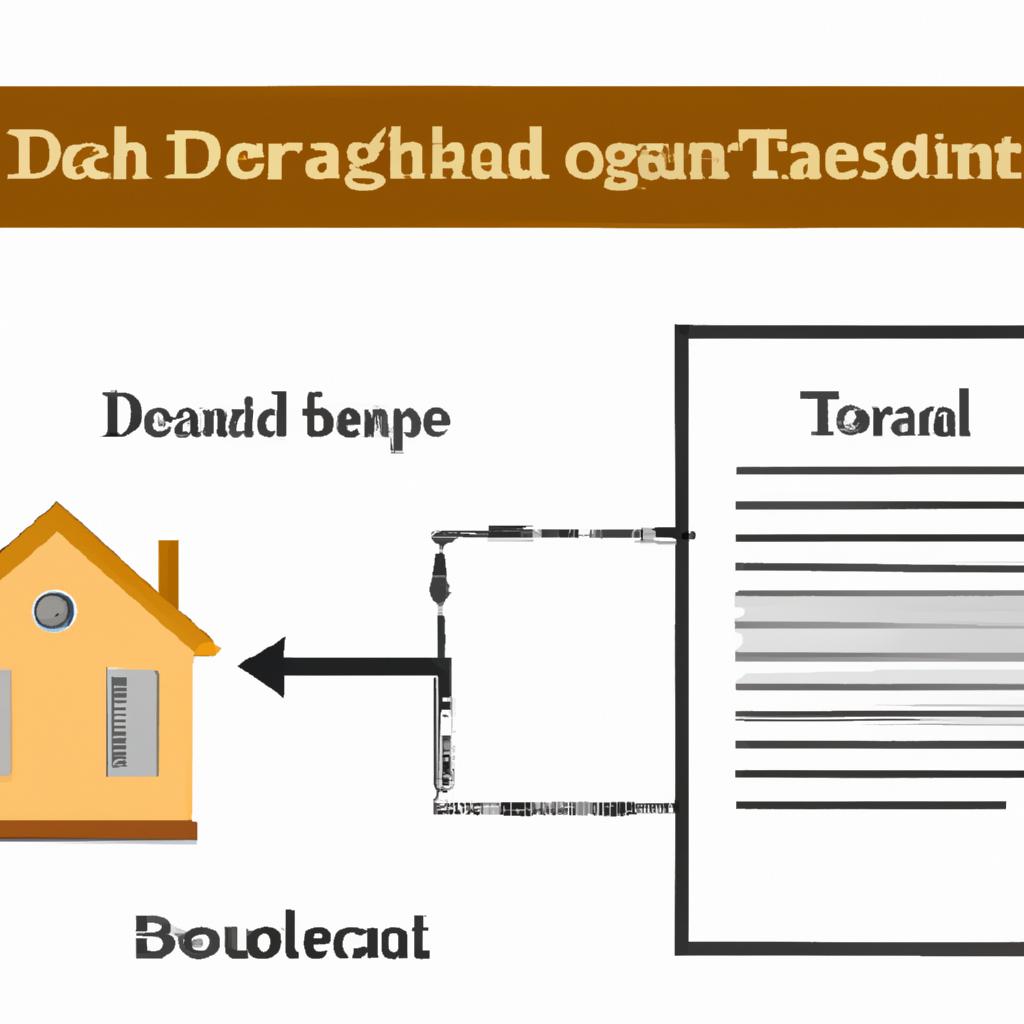When an individual passes away, a myriad of legal matters must be addressed, including the transfer of their house deed. This crucial process ensures that the deceased’s property is appropriately passed on to their heirs or beneficiaries in accordance with their wishes. At Morgan Legal Group in New York City, our experienced team specializes in estate planning, probate, elder law, Wills, and trusts, guiding clients through the intricate complexities of property transfer upon death with precision and expertise. Join us as we delve into the intricate world of transferring house deeds upon death and the crucial steps involved in ensuring a seamless transition of ownership.
Understanding the Mechanics of House Deed Transfer Upon Death
When a homeowner passes away, the transfer of the house deed can be a complex and daunting process. Understanding the mechanics of this transfer is crucial to ensure a smooth transition of ownership. There are several key factors to consider when navigating the legalities of house deed transfer upon death:
<ul>
<li><strong>Probate Process:</strong> The probate process is often required to transfer the ownership of the house deed to the rightful heirs. This legal process involves proving the validity of the deceased's Will, identifying the beneficiaries, and distributing the assets accordingly.</li>
<li><strong>Title Transfer:</strong> Once the probate process is complete, the title of the property can be transferred to the heirs or beneficiaries. This typically involves submitting the necessary paperwork to the county recorder's office to update the ownership records.</li>
</ul>| Important Considerations: | Ensure the deceased’s Will is valid and up-to-date. |
|---|---|
| Consult with a knowledgeable estate planning attorney to navigate the legal processes. |
<p>Overall, is essential to protect the interests of the deceased's estate and ensure a seamless transition of ownership. At Morgan Legal Group, our experienced attorneys specialize in estate planning and probate matters, guiding our clients through the complexities of transferring house deeds and other assets.</p>
Key Considerations for Avoiding Probate in House Deed Transfer
When it comes to transferring a house deed upon death, there are several key considerations to keep in mind in order to avoid probate. One important aspect to consider is ensuring that the property is properly titled. This means making sure that the deed clearly states who the owners of the property are and how they hold title. Joint tenancy with rights of survivorship or tenancy by the entirety are common ways to hold title that can help avoid probate.
Another consideration is the use of a revocable living trust. By transferring the property into a trust, it can pass directly to the designated beneficiaries upon the owner’s death, without having to go through probate. It’s important to regularly review and update the trust to ensure that it accurately reflects the owner’s wishes and current circumstances. Additionally, designating beneficiaries on retirement accounts and life insurance policies can also help avoid the need for probate.

The Implications of Different Forms of Ownership on House Deed Transfer
When it comes to the transfer of house deeds upon death, the form of ownership of the property plays a crucial role in determining how the transfer takes place. Different forms of ownership, such as sole ownership, joint tenancy, tenancy in common, and community property, have distinct implications on the process of transferring a house deed.
- Sole Ownership: In cases of sole ownership, the house deed will typically pass through the deceased owner’s estate according to their Will or state laws of intestacy.
- Joint Tenancy: If the property is held in joint tenancy with rights of survivorship, the surviving joint tenant automatically inherits the deceased owner’s share of the property.
| Form of Ownership | Transfer Process |
|---|---|
| Tenancy in Common | The deceased owner’s share of the property passes through their estate and is distributed according to their Will or state laws of intestacy. |
| Community Property | The surviving spouse automatically inherits the deceased owner’s share of the property. |

Strategies for Ensuring Smooth House Deed Transfer After Death
When it comes to ensuring a smooth house deed transfer after death, there are several strategies that can be implemented to streamline the process. One effective method is to establish a living trust, which allows for the transfer of assets, including real estate, to beneficiaries without having to go through probate. By setting up a living trust, you can designate who will inherit your home and avoid the costly and time-consuming probate process.
Another important strategy is to regularly review and update your estate planning documents, including your Will and any trusts you have established. By keeping these documents current, you can make sure that your wishes are accurately reflected and that your assets, including your home, will be transferred according to your desires. Additionally, it is crucial to communicate with your loved ones about your estate plan to avoid any potential conflicts or misunderstandings after your passing.
Q&A
Q: What happens to a house deed upon the death of the owner?
A: When the owner of a house passes away, the deed to the property must be transferred to the rightful heirs or beneficiaries.
Q: How is the transfer of a house deed processed after death?
A: The transfer of a house deed after death typically involves probate court proceedings, where the deceased’s property is distributed according to their will or state laws of intestacy.
Q: Can a house deed be transferred without going through probate?
A: In some cases, a house deed can be transferred without going through probate if the deceased had a trust set up or other estate planning measures in place to avoid probate.
Q: What are the possible complications that can arise during the transfer of a house deed upon death?
A: Complications that can arise during the transfer of a house deed upon death include disputes among heirs, unresolved debts or liens on the property, or issues with the validity of the deceased’s will.
Q: How can one ensure a smooth transfer of a house deed upon their death?
A: To ensure a smooth transfer of a house deed upon their death, individuals should consider creating a will, setting up a trust, and keeping their estate planning documents up to date. It’s also important to communicate intentions and wishes with family members to avoid conflicts.
In Retrospect
In conclusion, navigating the transfer of a house deed upon death can be a complex and emotional process. By understanding the legal considerations and taking proactive steps to communicate your wishes with loved ones, you can ensure a smooth transition of property ownership after you pass away. Remember, seeking advice from legal professionals and estate planners can provide invaluable guidance in safeguarding your assets for the future. Ultimately, by planning ahead and ensuring all necessary documents are in place, you can ease the burden on your family and preserve your legacy for generations to come.
 Q: What Is Transfer of House Deed Upon Death and How Does It Work?
Q: What Is Transfer of House Deed Upon Death and How Does It Work?
The transfer of a house deed upon death is a legal process that takes place when a homeowner passes away. It involves transferring ownership of the deceased’s property to another person or entity, often a family member or designated beneficiary. This process can be complex and overwhelming, but understanding how it works can help prepare you for any potential transfers in the future. In this comprehensive guide, we’ll explain everything you need to know about the transfer of house deed upon death, from its purpose and benefits to practical tips and real-life examples.
The Purpose of Transfer of House Deed Upon Death
The main purpose of transferring a house deed upon death is to ensure that the deceased’s property is properly handled and distributed according to their wishes. By transferring the deed, the ownership of property is formally and legally passed on to the designated beneficiary, avoiding any potential disputes or challenges from other parties.
Another purpose of transferring a house deed upon death is to expedite the distribution of assets and avoid probate. Probate is the legal process of validating a will and distributing assets to the designated beneficiaries. Depending on the complexity of the estate, this process can take months or even years. By transferring the house deed upon death, the property can be transferred directly to the designated beneficiary, saving them time and money in the long run.
How Does It Work?
The transfer of a house deed upon death works differently depending on the state laws and the type of property involved. Generally, there are three main ways in which this transfer can take place: joint tenancy with right of survivorship, transfer on death deed, and living trust.
Joint Tenancy with Right of Survivorship
Joint tenancy with right of survivorship is a type of co-ownership where multiple individuals are named on the property’s deed. When one owner passes away, their share automatically transfers to the surviving owners without going through probate. This type of ownership is common among married couples, but it can also apply to family members or business partners.
Transfer on Death (TOD) Deed
A transfer on death deed is a revocable transfer of ownership of real estate upon the owner’s death. This means that the owner can change or revoke the transfer during their lifetime, but upon death, the property will be automatically transferred to the designated beneficiary. This type of deed can be useful in avoiding probate and ensuring that the property goes to the intended heir.
Living Trust
A living trust is a legal document that allows a person to transfer their assets, including real estate, to a trust while they are still alive. The trust becomes the owner of the property, and upon the owner’s death, the trust distributes the property to the designated beneficiaries. Living trusts are often used to avoid probate and offer more control over the distribution of assets.
Practical Tips for Transfer of House Deed Upon Death
If you are planning on transferring a house deed upon death, it is essential to follow these practical tips to ensure a smooth and successful process:
1. Consult a Legal Professional
The transfer of a house deed upon death is a complex legal process that involves various laws and regulations. Consulting with a legal professional, such as an estate planning attorney, can help you navigate through the process and ensure that the transfer is done correctly. An experienced lawyer can also help you decide which transfer method works best for your specific situation.
2. Keep the Deed Accurate and Up-to-Date
It is essential to ensure that the house deed is accurate and up-to-date, especially if it has been a while since the deed was last updated. Any discrepancies or missing information can cause delays and complications in the transfer process. If necessary, consider updating or amending the deed to reflect any changes since the last update.
3. Consider Gifting the Property
Transferring ownership of a property as a gift during your lifetime can have several benefits, including avoiding probate and reducing estate taxes. However, it is crucial to follow the gifting rules and regulations set by the state and federal laws to avoid any legal issues or liabilities.
Real-Life Examples
To further understand how the transfer of a house deed upon death works, let’s look at two real-life examples:
Case Study 1: Joint Tenancy with Right of Survivorship
John and Mary are a married couple who own a home as joint tenants with right of survivorship. When John passes away, his share of the property automatically transfers to Mary without going through probate. As the surviving owner, Mary now owns the property entirely and can transfer ownership to anyone she chooses upon her death.
Case Study 2: Transfer on Death (TOD) Deed
David is an elderly individual who wanted his niece, Sarah, to inherit his property upon his death. To avoid the lengthy and complicated probate process, David decides to use a transfer on death deed. He fills out the required form, naming Sarah as the beneficiary, and registers it with the county recorder’s office. When David passes away, Sarah automatically inherits the property, and the deed is transferred to her name without going through probate.
In conclusion, the transfer of a house deed upon death is a crucial process that ensures a smooth transfer of property ownership and avoids potential disputes or delays. By understanding how it works and following practical tips, you can plan ahead and make the process as seamless as possible for your loved ones. Consult a legal professional for personalized advice and guidance, and consider using gifting or a trust to better manage your assets and secure your property’s future.










